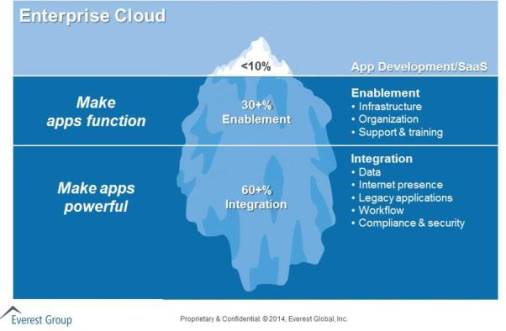Digital Enterprise Iceberg
We all understand the power of digital — it enables us to change the way we interact with our customers, employees, vendors and governments. Getting interactions right with those stakeholder groups gives us powerful strategic advantages. However, the digital world is like an iceberg, and we tend to see only the tip. Below the water is a mass of ice that can sink digital outcomes just as it sunk the Titanic.
Companies that can change their stakeholder conversations in a meaningful way can change the game, changing the competitive landscape almost overnight, reaping enormous wealth. Wal-Mart and Interstate Battery achieved this outcome when they changed their supply chains. And Amazon, Google and H&R Block completely changed the game in their markets.
So what’s the problem?
The business stakeholders see the tip of the iceberg. But the CIOs recognize that 90 percent of the expenses are below the surface and initially can’t be seen.
What we’re finding at Everest Group is that when companies switch to the digital world — such as creating a mobile app as a new way of communicating with Millennials about insurance offerings — there are huge pull-through implications on the rest of the organization.
For example, the company’s vendor systems may not be set up to interface to the new mobile app. Sure, the digital product enables the company to be able to spot new customers as they emerge. But the company needs to change its organizational systems to move into this instantaneous world so that the company can react quickly enough to take advantage of these opportunities or operate in a way that is digitally friendly in this new world.
We’ve all been through the experiences of the impact of the portion of iceberg under the water … such as the half promise when we’ve visited a website or used a mobile app to find we can only go part of the way. We get frustrated when the promise isn’t fulfilled.
As the figure above illustrates, many companies find a huge body of work that is not obvious when they start down the digital path. Although it looks like the cost and time required for launching a mobile app is small, the cost of getting to a great customer experience is high because it often requires huge amounts of infrastructure, application changes and organizational change to live in the new world.
In addition to the cost and time, there are other business risks in the iceberg portion below the water. And aligning the organization so it can operate at digital time requires significant effort and change management tactics. We tend to operate from committees. But in the digital world, that takes too long; it must be instantaneous.
Finally, providers need to venture into this new digital world while they still maintain the old world, thus increasing their investments in services capabilities. There are significant costs involved in dealing with the risks in the part of the iceberg hidden under the water.



